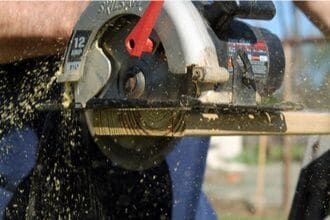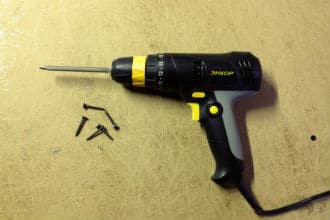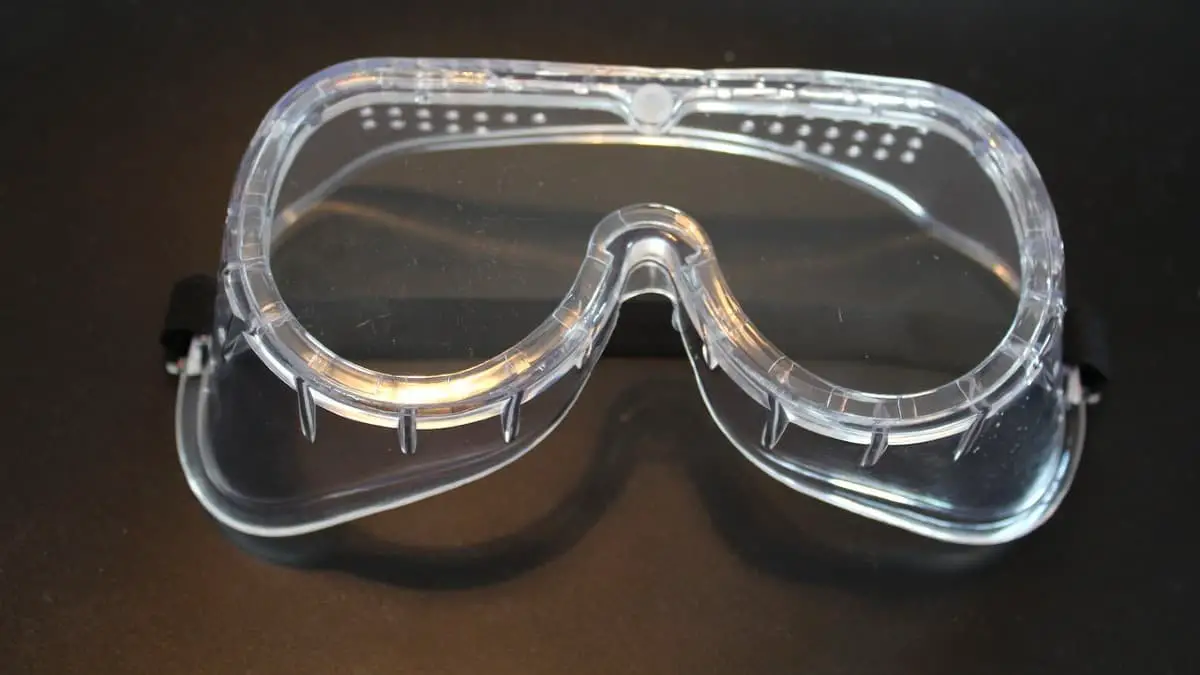In this blog post, we will talk about dangerous woodworking tools. Not all tools are the same: some are clearly more hazardous than others. There are many ways to cut a piece of wood. You need to find methods that are effective, efficient, and also safe.
Modern tools allow the woodworker to make his projects in a convenient way. The saw blades are very sharp. They rotate at high speed. They make very precise cuts. Some portable drills have power ratings over 1/2 horsepower. Also, some Table / Bench Saws have ratings over 3 Horsepower! It’s hard to imagine how it was when the early pioneers put together homes by hand, with no electricity or power tools.
We need to consider that modern power tools are inherently dangerous. Follow all safety rules! Take extreme care! Otherwise, unfortunate accidents can happen:
- The estimated number of Table / Bench Saw accidents seen in an Emergency Room was 39,750 per year.
- The injuries related to Table / Bench saws make up 78% of the total for all stationary saws (i.e., Table / Bench saws, Band Saws, Radial Arm Saws, and Miter Saws)
- Injuries were due to the sharp blade in 88% of the instances.
Dangerous Woodworking Tools: Safety Steps
In general, you should follow particular safety steps with all power tools:
- Don’t use them when you aren’t alert.
- Never take shortcuts. We all know that it takes time to keep on setting up the equipment and/or reclamping after a cut. However, you need to methodically go through all steps. As an example, you need for the blade to stop rotating completely before removing the wood from the saw.
- Completely remove power (That is, don’t just turn the saw off) before changing the blade or adding an attachment.
- Don’t use broken tools.
- Only use tools that operate properly.
- Make sure that all clamps are tight.
- Do not use a tool that doesn’t have adequate power or speed.
- Don’t defeat the purpose of any safety guides included with the tool. Don’t remove them after changing a blade, or setting up.
Here is a list of some dangerous tools:
1. Dangerous Woodworking Tools: Table Saw / Bench Saw
This is one of the most common tools in the workshop. Almost any type of cut, for any woodworking project, can be made with this type of tool. These would include “rip cuts” (cuts along the grain of the wood) as well as “crosscuts” (cuts across the grain of the wood). In addition, one can make other specialized cuts.
Safety Features
Most modern Saws include certain safety features:
- Large table areas can help when supporting larger pieces of wood. This can help to minimize wood binding. This potentially dangerous situation can occur when the motion of the wood is not entirely parallel to the plane of the rotating blade.
- Blade Guards cover the Blade so as to make it more difficult for fingers to contact it. You do not want to defeat the purpose of this guard. Make sure to put it back in place after changing the blade, etc.
- Wood binding can also case kickback. Wood gets caught in the blade. It is then thrown back towards the operator. The impact, by itself, can cause great injury. The operator can be thrown into the saw blade! Several guides help to avoid this: First, a Splitter prevents the cut edges of the wood from closing in and contacting the blade teeth in the back. Also, Anti Kickback Pawls prevent the wood from being propelled towards the operator. Another safety device is the Riving Knife. This is similar to the Splitter.
- A push stick helps to push a narrow piece of wood through the saw so your fingers don’t get too close to the blade. Even with the blade guard cover in place, your fingers can get too close to the blade.
- You should also wear safety glasses. This is because the wood can often chip, pieces can be thrown up into the eyes.
- Don’t wear clothing that can get caught.
- Don’t wear clothing that can get in your way as you operate the machinery.
2. Circular Saw – Handheld
This is generally a portable or handheld saw. It can make crosscuts. Also, it can rip large paneling pieces. Finally, it’s very easy to use.
However, there are problems with this tool: For one thing, an operator holds the saw in his hand: The saw blade spins ar 5000 RPM or so, and the power can be 2 HP or even more. So, how does it differ from the Table / Bench Saw? Can’t we just follow the same precautions?

Well, not exactly. The hand circular saws generally have a switch that turns off when the user releases the hand trigger grip. A spring-loaded blade guard usually covers the rotating blade on the bottom. However, this can take time. The blade can still be rotating after finishing the cut. You should wait for the blade to stop spinning before putting the saw down. If this is not done, the saw can “shoot off”. It can be propelled by the rotating blade. Regardless of guards that snap into place, there is always danger when a tool is not under your full control.
Also, keep in mind that binding and kickback effect circular saws as well as Table / Bench Saws.
3. Dangerous Woodworking Tools: Router – High Speed / Power
Routers can shape wood. Also, they can make specialized cuts such as dovetails, dados, etc. They may have a power rating greater than 2 HP or so, with bits rotating at around 18,000 RPM. This is so that clean cuts can be made. Also, it reduces chipping.
However, you need to realize that all handheld tools can have a tendency to “jump” when you hit a hard section of the wood, such as a knot. This can also happen when a wood clamp comes loose. However, you must always maintain control of the tool! If the tool gets free it can cause a lot of damage.
Along with the precautions already mentioned, you need to make sure that the wood you are working on is well-clamped and secure. Avoid the tendency to “save time” by moving wood along without re-clamping. Don’t take any shortcuts!
4. Dangerous Woodworking Tools: Jointer – Planer
Are you gluing wood? Do you need square edges? Then, you might use a jointer-planer. Table saws do not make edges “square”. That is, the edges are not all 90 degrees to each other and the width of the board is not totally constant. As a result, glued boards would have seams with “gaps”. This would prevent you from making neat table surfaces, for example.
The wood jointer cleans these things. However, there are sharp rotating chisel-type knives pointing up at you, as you press the wood down.
Some safety devices include:
- Like with the Table / Bench Saw, you might want to use a push stick. The general idea is to keep your fingers away from the rotating planer knives.
- Another device is the push pad. This has a surface that holds on to the wood when you apply pressure to it. You can then move the wood along without having your hands on the wood surface itself. While this offers some protection, you need to remember that you are still pushing towards the dangerous rotating chisel knife blades.
- Also, there is a spring-loaded blade guard on jointers. It snaps back to cover the blades after the wood passes through. This is of some value. However, your fingers can touch the blades. Be careful!
5. Radial Arm Saw – Pull Toward You
The next tool on the list is the Radial Arm Saw. This “giant slicer” is of real help when making precise crosscuts and wood joints. The motor and saw blade rides on a movable arm.
Most Radial Arm Saws have certain safety features:
- There is often a blade guard. This gets pushed up as the blade approaches the wood. Once you pass it, the guard drops back down.
- Next, you often have some sort of “Anti-Kickback Device”. Generally, this is used for Rip cuts when done on the Radial Arm Saw. First, turn the Blade / Motor assembly 90 degrees and lock into position. Then the board to be “Ripped” is pushed in from the back of the Blade / Motor assembly (against the blade rotation). If it kicks back and is drawn towards the operator, the Kickback device locks the wood in place.
The Radial Arm Saw is certainly a very versatile tool. It can make almost any sort of cut you need. However, you need to follow safety precautions:
- When doing a crosscut, the Motor / Blade assembly is moved towards you. Always stand to the side and make sure you remain a distance from the blade.
- When setting up the saw, make sure that gravity pushes the Motor / Blade assembly backward, towards the direction of the fence. In particular, you do not want the blade to come out toward you if you are not holding the handle.
- Wait for the blade to reach full speed after turning the saw on, before making your cut. There is a greater chance of kickback if the blade is not running at full speed.
- Even if the blade has a guard, keep your fingers away from the blade.
- Wear eye protection.
6. Dangerous Woodworking Tools: The Stapler?
The wood stapler is used for quickly taking pieces into places, such as moldings or trims. Another use is to attach bats of insulation to wood studs.
You may be surprised to see this on the list. After all, paper staplers are used all the time. How dangerous can a Wood Stapler be?
Actually, it may not be as dangerous as some of the other tools on this list. However, there is a tendency for the staples to go through fingers and other body parts.
Be careful and make sure that this does not happen! Also, always wear eye protection when using this tool.
7. Some Drill Accessories
Drills are often considered safe tools for beginners. The bits spin at moderate speeds, much slower than router bits. In fact, many drills have a variable speed feature, The hand trigger allows the operator to control the bit rotation speed. As another feature, some drills are reversible and allow you to change rotation direction.
Drills are versatile tools. They can do things like mix paint, rotate sanding wheels or drums or grinding wheels, or drill pilot holes for wood screws. So, are they dangerous?

Actually, you need to be concerned with flimsy drill accessories. These might spin around, and “chip” pieces of wood out. Things are all right if the contraption holds together. However, such things have been known to fall apart while rotating. When they do this, they spew forth dangerous material.
Generally, such devices are underpowered. That is, they require more power and/or speed to cleanly cut the wood. Underpowered tools can also bind. They can either jolt the tool from the hand or throw wood out of a clamp.
Here are a few safety steps:
- Make sure that everything is secure. Be observant and look for loosening or rattling as the drill speed is increased.
- In general, it is better to use “the real tool” rather than a drill accessory. The “real tool” will have the speed and power needed to do the task properly.
- Wear eye protection.
Dangerous Woodworking Tools: Conclusion
In this guide, we have looked at a few of the more dangerous woodworking tools. We have described some of the safety features they have, and also listed some of the precautions to follow with that tool.
In addition, we list general safety precautions to take with all woodworking tools. One of the most important is: Don’t take shortcuts. So, pull out the plug before changing blades. Set things up properly. Make sure that clamps are secure.
- Do not defeat the purpose of the safety features provided with the tool, such as Blade Guards, Anti-KickBack devices, etc. Use these safety devices. Do not operate the tools without them in place.
- Also, it is important to wear eye protection. Wood chips and sawdust can interfere with vision.
- Make sure to follow all of the manufacturer’s instructions when using tools produced by them.
Don’t forget to follow my boards on Pinterest. Did you enjoy reading this post? If so, please share.

